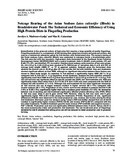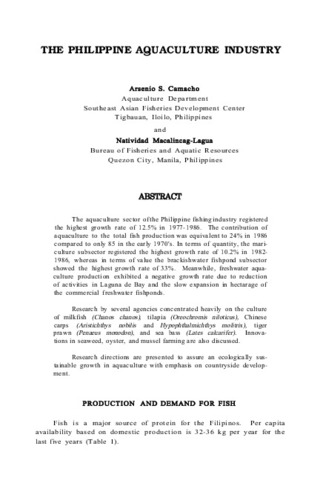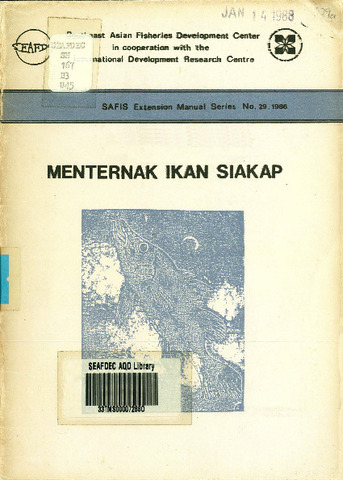Netcage rearing of the Asian seabass Lates calcarifer (Bloch) in brackishwater pond: The technical and economic efficiency of using high protein diets in fingerling production
Share
Abstract
Intensification in the grow-out culture of high-value fish requires a large quantity of quality fingerlings. Fingerling production is a component of fish farming that comprises nursery and grow-out culture, and may be a commercial enterprise option for fish farmers with limited pond area. The nursery rearing of the Asian seabass Lates calcarifer (Bloch) was conducted in netcages inside a brackishwater pond. The fish were fed with two isocaloric, high-protein diets formulated at the Southeast Asian Fisheries Development Center (SEAFDEC/AQD) and a control treatment: diets A (40.40% crude protein, CP) and B (46.17% CP), and trashfish (TF) as control. Hatchery-bred seabass early juveniles of two size groups (S1, 4.0 ± 0.2 g; S2, 2.40 ± 0.03 g) were stocked at 75–100 fish per m3 and given diets A or B at 6–10% of average body weight (ABW) d-1, or TF at apparent satiation. Seabass given the formulated diets attained the desired size (≥ 20–40 g) after 45 d but not the fish fed with trashfish. Size and treatments showed significant effects on final ABW, although no significant interaction between these factors was shown to affect body weight. As expected, S1 fish attained a significantly higher ABW (30.7 ± 18 g) compared with S2 fish (20.7 ± 11 g) regardless of diet treatment. Seabass fed with trashfish exhibited significantly lower final ABW (6.6 ±1.6 g) than those fed Diet A (33.4 ± 6.5 g) or Diet B (37.1 ± 9.4 g). Fish size did not have any significant effect on specific growth rate (SGR), but diet treatments did. SGR was significantly better when either Diet A (5.2 ± 0.30) or B (5.4 ± 0.20) was used compared with the SGR of seabass fed with trashfish (1.7 ± 0.5). Although size and treatment did not show significant interaction on fish survival, the use of bigger seabass resulted in higher survival (89 ± 11%) compared with smaller seabass (80 ± 11%). Regardless of size, similar survival was attained in seabass fed Diet A (89 ± 6%) or B (95 ± 5%), significantly higher than that in seabass given trashfish (72 ± 6%). An interaction between size at stocking and diet treatment significantly affected protein efficiency ratio (PER). When S1 fish was used, diets A and B gave similar PER. However, when S2 fish was used, diet A gave significantly higher PER (2.49 ± 0.02) among the treatments (P < 0.05). Regardless of size, significant differences (P ≤ 0.05) were observed in the mean production cost, revenue and income among the three diet treatments. Moreover, post hoc analysis using Tukey’s HSD test further showed that use of diet B resulted in significantly higher revenue (PhP25,132.80) and income (PhP12,597.47) compared with the two other treatments. Trashfish treatment gave the least revenue (PhP 9,525.60) and negative income (- PhP 1,798.40). Production cost was not significantly different between diets A and B. Hence, diet B is the most economically viable and productive diet treatment. The low break-even price of fingerlings obtained for diet B showed that selling price can still be reduced to lower production cost in grow-out farming.
Suggested Citation
Madrones-Ladja, J. A., & Catacutan, M. R. (2012). Netcage rearing of the Asian seabass Lates calcarifer (Bloch) in brackishwater pond: The technical and economic efficiency of using high protein diets in fingerling production. The Philippine Agricultural Scientist , 95(1), 79-86. http://hdl.handle.net/10862/2126
Subject
Taxonomic term
Collections
- AQD Journal Articles [1249]
Related items
Showing items related by title, author, creator and subject.
-
The Philippine aquaculture industry
Camacho, Arsenio S.; Macalincag-Lagua, Natividad (Aquaculture Department, Southeast Asian Fisheries Development Center, 1988)The aquaculture sector of the Philippine fishing industry registered the highest growth rate of 12.5% in 1977-1986. The contribution of aquaculture to the total fish production was equivalent to 24% in 1986 compared to ... -
Menternak ikan siakap
Information and Publication Unit, Fishery Conservation and Extension Division, Department of Fisheries, Thailand; Diah, Nik Ab. Wahab bin Mat (Secretariat, Southeast Asian Fisheries Development Center, 1986-01)The purpose of this paper is to provide information on how to raise sea bass (Lates calcarifer) in ponds and cages as has been done in Thailand. This includes all technical aspects such as site selection, seed collection, ... -
Culture of sea bass
Information and Publication Unit, Fishery Conservation and Extension Division, Department of Fisheries, Thailand; Srisuwantach, Vijai (Secretariat, Southeast Asian Fisheries Development Center, 1984-07)Sea bass or giant sea perch, known as pla kaphong, pla kaphong khao, or pla kaphong namjerd in Thailand, is one of the large brackishwater fish. The species is found mainly in estuaries and mangrove swamps adjacent to the ...




